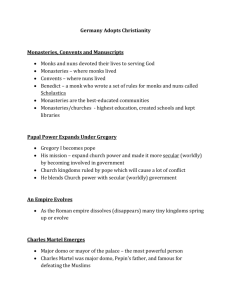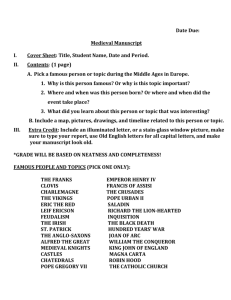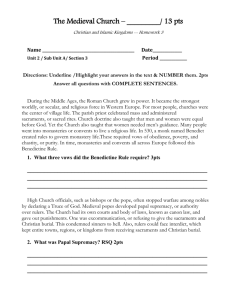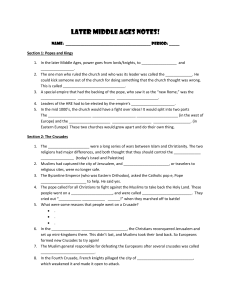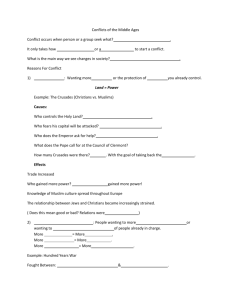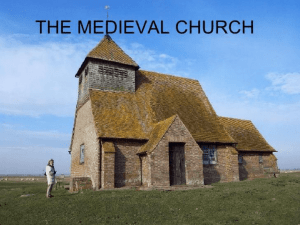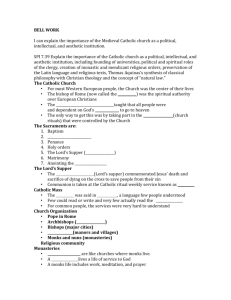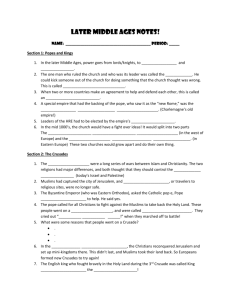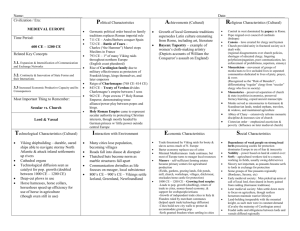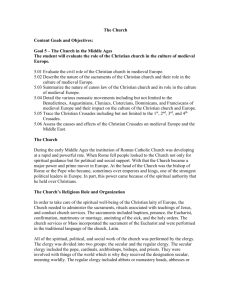File
advertisement
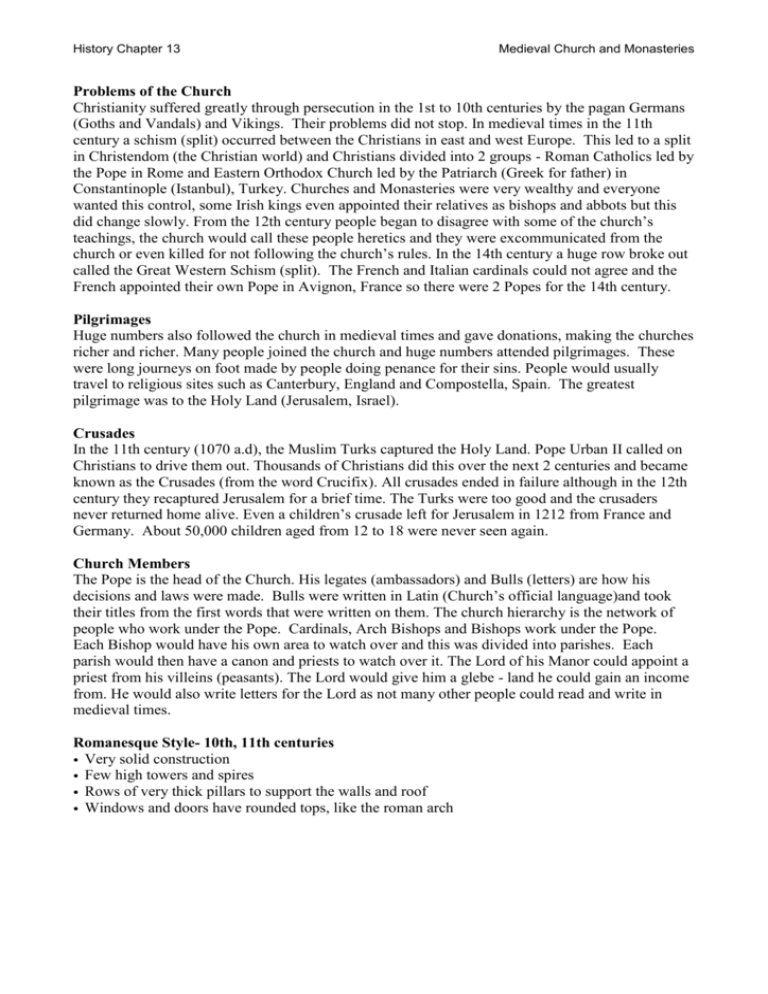
History Chapter 13 Medieval Church and Monasteries Problems of the Church Christianity suffered greatly through persecution in the 1st to 10th centuries by the pagan Germans (Goths and Vandals) and Vikings. Their problems did not stop. In medieval times in the 11th century a schism (split) occurred between the Christians in east and west Europe. This led to a split in Christendom (the Christian world) and Christians divided into 2 groups - Roman Catholics led by the Pope in Rome and Eastern Orthodox Church led by the Patriarch (Greek for father) in Constantinople (Istanbul), Turkey. Churches and Monasteries were very wealthy and everyone wanted this control, some Irish kings even appointed their relatives as bishops and abbots but this did change slowly. From the 12th century people began to disagree with some of the church’s teachings, the church would call these people heretics and they were excommunicated from the church or even killed for not following the church’s rules. In the 14th century a huge row broke out called the Great Western Schism (split). The French and Italian cardinals could not agree and the French appointed their own Pope in Avignon, France so there were 2 Popes for the 14th century. Pilgrimages Huge numbers also followed the church in medieval times and gave donations, making the churches richer and richer. Many people joined the church and huge numbers attended pilgrimages. These were long journeys on foot made by people doing penance for their sins. People would usually travel to religious sites such as Canterbury, England and Compostella, Spain. The greatest pilgrimage was to the Holy Land (Jerusalem, Israel). Crusades In the 11th century (1070 a.d), the Muslim Turks captured the Holy Land. Pope Urban II called on Christians to drive them out. Thousands of Christians did this over the next 2 centuries and became known as the Crusades (from the word Crucifix). All crusades ended in failure although in the 12th century they recaptured Jerusalem for a brief time. The Turks were too good and the crusaders never returned home alive. Even a children’s crusade left for Jerusalem in 1212 from France and Germany. About 50,000 children aged from 12 to 18 were never seen again. Church Members The Pope is the head of the Church. His legates (ambassadors) and Bulls (letters) are how his decisions and laws were made. Bulls were written in Latin (Church’s official language)and took their titles from the first words that were written on them. The church hierarchy is the network of people who work under the Pope. Cardinals, Arch Bishops and Bishops work under the Pope. Each Bishop would have his own area to watch over and this was divided into parishes. Each parish would then have a canon and priests to watch over it. The Lord of his Manor could appoint a priest from his villeins (peasants). The Lord would give him a glebe - land he could gain an income from. He would also write letters for the Lord as not many other people could read and write in medieval times. Romanesque Style- 10th, 11th centuries • Very solid construction • Few high towers and spires • Rows of very thick pillars to support the walls and roof • Windows and doors have rounded tops, like the roman arch History Chapter 13 Medieval Church and Monasteries Gothic Style - 12th, 13th centuries • Taller than earlier churches • High bell towers and spires (fleches - french for arrows) • Thinner walls supported by thick stone ribs between windows • Outer stone props called flying buttresses ( support arches) • Inside support pillars slimmer in size • Windows and doors have pointed tops • Windows can be placed very close together • Gothic design work (tracery work) at the tops of the windows • Huge circular rose windows of stained glass Monks Churchmen living among the people were called secular clergy. Churchmen living in monasteries were called regular clergy. (regula = Latin rule) Before 1a.d most clergy took vows of poverty, fasting and separation from society. As the church grew wealthy and powerful, they soon forgot these vows. Members did not like this so they began to set up their own orders of clergy and they had strict rules of work, fasting, prayer and wearing plain clothes. - St. Bernard set up the Cistercian order in the 12th century in Citeaux, France. - Clunics order set up at Cluny, France - Carthusians order set up at Chartreuse, France (lived in silence and ate one meal a day) Daily life of these new monks - monks would shave the tops of their head to show devotion to God, called tonsures. - Read the scriptures, one monk called the lector, read aloud while the others ate - Work on the land to provide food Work at crafts (carpentry and metal work) - Scribes worked on the manuscripts Mass at least once a day - Infirmarian looked after the sick Refectorian prepared the meals - Great master looked after the guest house Almoner looked after the poor (give alms) - Bursar looked after the money Prior was the assistant to the abbot - Abbot was the head of the monastary - formal prayers, called offices up to 7 times a day - 10 to 50 minutes long 1. Matins 2am 2.Prime 5am (first hour) 3. Lauds 6am (psalms) 4. Terce 9am (3rd hour) 5. Sext 12pm (6th hour) 6. None 3pm (9th hour) 7. Vespers 6pm 8. Compline Bed (completed day) New Orders More new orders set up in the 13th century. Church members kept growing. Franciscan and Dominican orders. They were called-Friars (French for brother) and took vows of poverty, obedience, chastity. They also went out among the town’s people to help them. Nuns Convents (nunneries) were also set up. Nuns were more enclosed and rarely left the convent. Their main work was the education of girls. There are Franciscan, Dominican, Augustinian and Carmelite nuns. Widows of rulers would also enter convents after their husband had died.
